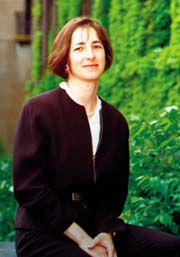Scientists light a path for new nerve cells

Molly S. Shoichet <br>Associate Professor Ph.D. (University of Massachusetts) <br>Credits: U of Toronto
System for guiding cell migration, adhesion has biomedical and regenerative medical applications
Scientists at the University of Toronto are taking regenerative medicine to a new dimension with a process for guiding nerve cells that could someday help reconnect severed nerve endings.
Molly Shoichet, a professor of chemical engineering and applied chemistry at the Institute for Biomaterials and Biomedical Engineering (IBBME), has devised a new method that helps guide cell migration and adhesion. “We’re very interested in using this system for biomedical applications and regenerative medicine, specifically for guiding nerve cells,” says Shoichet, who holds the Canada Research Chair in Tissue Engineering.
In the study, Shoichet and doctoral student Ying Luo combined a gel-like substance called agarose with compounds having “photolabile” properties that change chemically when exposed to light. When they directed laser light at the gel, its chemical composition changed, creating a “channel” through the gel. Although not a physical channel, the interaction created a “growth-friendly” chemical pathway through the agarose.
Luo then placed neural cells at the opening of the channels. She and Shoichet found that the cells migrate into and through the channels, filling the pathways rather than clinging to the periphery. “Our findings have important implications for guiding where cells go and providing a greater surface area for the neural stimuli to be transmitted,” she says. Shoichet adds that it is not yet known whether this will lead to stronger signals passing through regenerated nerves.
“This is the first example of doing 3-D patterning with this type of gel material and is applicable to transparent materials,” says Shoichet. While previous techniques have created three-dimensional gel structures, they involved a time-consuming layering process.
The study, which appears in the March 21 advanced online publication of the journal Nature Materials, was funded by the Natural Sciences and Engineering Research Council of Canada, an Ontario Graduate Scholarship and a Connaught Fellowship.
Media Contact
More Information:
http://www.news.utoronto.ca/bin5/040323a.aspAll latest news from the category: Life Sciences and Chemistry
Articles and reports from the Life Sciences and chemistry area deal with applied and basic research into modern biology, chemistry and human medicine.
Valuable information can be found on a range of life sciences fields including bacteriology, biochemistry, bionics, bioinformatics, biophysics, biotechnology, genetics, geobotany, human biology, marine biology, microbiology, molecular biology, cellular biology, zoology, bioinorganic chemistry, microchemistry and environmental chemistry.
Newest articles

A universal framework for spatial biology
SpatialData is a freely accessible tool to unify and integrate data from different omics technologies accounting for spatial information, which can provide holistic insights into health and disease. Biological processes…

How complex biological processes arise
A $20 million grant from the U.S. National Science Foundation (NSF) will support the establishment and operation of the National Synthesis Center for Emergence in the Molecular and Cellular Sciences (NCEMS) at…

Airborne single-photon lidar system achieves high-resolution 3D imaging
Compact, low-power system opens doors for photon-efficient drone and satellite-based environmental monitoring and mapping. Researchers have developed a compact and lightweight single-photon airborne lidar system that can acquire high-resolution 3D…





















